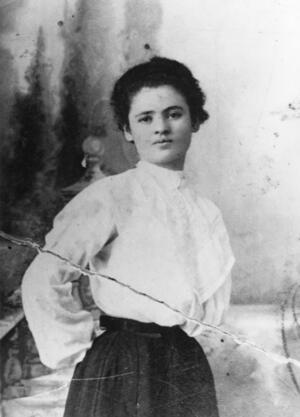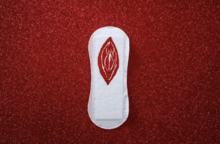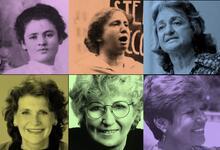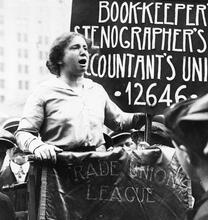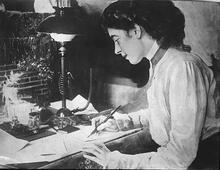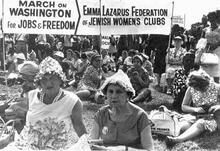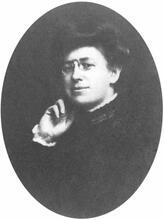Clara Lemlich Shavelson
As an immigrant garment worker in New York City, Clara Lemlich Shavelson began organizing women into the International Ladies Garment Workers Union in 1905, forcing male union leaders to include women workers in strikes. At a 1909 strike meeting at the Cooper Union, Shavelson’s fiery speech set off the Uprising of the 20,000, the largest strike by women workers to that date. She later focused on the suffrage movement and organized housewives around food boycotts, including the 1917 kosher meat boycott. In 1929, she helped found what later became the Progressive Women’s Councils, organizing women around rent strikes and food boycotts during the Great Depression. Shavelson continued her activism into her final years, helping the orderlies at her nursing home to organize a union.
Overview and Early Life
Clara Lemlich has made cameo appearances in histories of the United States, the labor movement, and American Jewry as the young firebrand whose impassioned Yiddish speech set off the 1909 Uprising of the 20,000, the largest strike by women workers in the United States to that time. She has even appeared in that context in the hit Broadway play and movie I’m Not Rappaport. But Clara Lemlich’s career as a revolutionary and activist began well before that famous speech and extended for more than half a century afterward. The most famous of the farbrente Yidishe meydlekh [fiery Jewish girls] whose militancy helped to galvanize the labor movement, she was also a suffragist, communist, community organizer, and peace activist. Clara Lemlich Shavelson lived and breathed politics from her childhood in revolutionary Russia to her last years in a nursing home in California—where she organized the orderlies.
Clara Lemlich was born in 1886 in Gorodok, Ukraine, to deeply religious parents. Like most girls, she was taught Yiddish but was offered no further Jewish schooling. Her parents were willing to send her to public school but found that Gorodok’s only school excluded Jews. Angered by the Russian government’s antisemitism, her parents forbade her to speak Russian or to bring Russian books into their home. The headstrong child continued her study of Russian secretly, teaching Russian folk songs to older Jewish girls in exchange for their volumes of Tolstoy, Gorky, and Turgenev.
Before she was in her teens, Clara was sewing buttonholes on shirts to pay for her reading habit. Already fluent in written Yiddish, she fattened her book fund by writing letters for illiterate mothers to send to their children in America. When her father found a cache of books hidden beneath a meat pan in the kitchen, he burned the whole lot and Clara had to start collecting again. She began storing books in the attic, where she would perch on a bare beam to read. One SabbathSabbath afternoon, while her family dozed, she was discovered by a neighbor. He not only kept her secret but lent her revolutionary tracts from his own collection. By the time the Kishinev pogrom of 1903 convinced her parents to immigrate to the United States, seventeen-year-old Clara was a committed revolutionary.
Garment Worker Organizing and the Uprising of 20,000
Like so many young immigrant girls, Clara Lemlich found work in a Lower East Side garment shop. Infuriated by working conditions that, she said, reduced human beings to the status of machines, she began organizing women into the fledgling International Ladies Garment Workers Union (ILGWU) soon after her arrival in New York in 1905. The older, skilled male workers who dominated the union resisted her efforts, but whenever they attempted to strike without informing the women, Clara brazenly warned them that their union would never get off the ground until they made an effort to include women. Over the men’s objections, she brought her women coworkers out on strike again and again in various garment shops between 1907 and 1909.
In November 1909, despite the warnings of male union officers and of the middle-class reformers of the Women’s Trade Union League who believed that young girls could not sustain a general strike, Clara decided to ignite the long-simmering resentment of tens of thousands of young immigrant working girls like herself. Insisting that she be allowed to address a strike meeting at New York’s Cooper Union, she said: “I am one of those who suffers from the abuses described here, and I move that we go on a general strike.” To the surprise of almost everyone, between thirty and forty thousand young women garment workers—predominantly Jewish immigrants—walked off their jobs over the next few weeks. It was a bitter, only partially successful strike. It galvanized the fledgling ILGWU and set off a wave of women’s strikes between 1909 and 1915 that spread from New York to Philadelphia, Cleveland, Chicago, Iowa, and Kalamazoo, Michigan. But it also set the stage for tragedy when union negotiators failed to advance the young women’s demand for safer working conditions. That lapse would come back to haunt the union on March 25, 1911, when the Triangle Shirtwaist Fire in New York City killed 146 workers, mostly immigrant Jewish and Italian women.
After the strike Clara was blacklisted from New York garment shops. She turned her energies to the suffrage movement, helping to found the Wage Earners League for Woman Suffrage, a working-class suffrage group. A fiery and effective agitator for the vote, she was eventually fired from her paid position as organizer for refusing to moderate her radical politics to suit the reform vision of most middle-class suffragists.
Boycott Organization and the Progressive Women’s Councils
In 1913, Clara married printer Joe Shavelson and moved to Brownsville, in Brooklyn, where they had three children—Irving, Martha, and Rita. Far from the shop floor, Clara Shavelson began organizing wives and mothers around such issues as housing, food, and public education. She was a leader in the Term used for ritually untainted food according to the laws of Kashrut (Jewish dietary laws).kosher meat boycotts of 1917, called to protest rapid price increases, and in the rent strike movement that swept New York City in 1919, when a postwar housing shortage dramatically raised the cost of decent housing.
In 1926, Shavelson joined the Communist Party and, along with other CP women, founded the United Council of Working-Class Housewives. The council helped the wives of striking workers raise funds, gather food, and set up community kitchens and cooperative child care. Organizing housewives proved so effective that, in 1929, Shavelson and white-goods worker Rose Nelson created the United Council of Working-Class Women (UCWW). The UCWW led rent strikes; anti-eviction demonstrations; meat, bread, and milk boycotts; sit-ins, and marches on Washington. Shavelson argued that consumption was intimately linked to production, and that the working-class housewife was as important a participant in the class struggle as her wage-earning husband, sisters, sons, and daughters.
In 1935, the UCWW changed its name to the Progressive Women’s Councils and began building a coalition with a wide range of women’s organizations not affiliated with the Community Party to protest the increasing cost of staple foods and housing. With Clara Shavelson as its president, the Progressive Women’s Councils mounted a meat boycott that shut down forty-five hundred New York City butcher shops. Though in New York the strike was centered in Jewish and African-American neighborhoods, it soon spread to Chicago, Detroit, Los Angeles, St. Louis, Minneapolis, Cleveland, and several towns in Pennsylvania, involving women of all races, religions, and ethnic backgrounds.
This housewives’ coalition alleviated the worst effects of the Great Depression in many working-class communities: bringing down food prices, rent, and utility costs; preventing evictions; and spurring the construction of more public housing, schools, and parks. By the end of World War II the housewives’ movement had forced the federal government to regulate food and housing costs and to investigate profiteering on staple goods. Decades of intense antieviction struggles and years of lobbying for public housing helped convince many municipalities to pass rent control laws, and increased support in Congress for federally funded public housing. It also paved the way for the modern consumer and tenant movements and brought gender politics into the working-class home, shining a bright light on hidden power relations between husbands and wives, parents and children—long before the feminists of the 1960s and 1970s popularized the thesis that the personal is political. By demanding to be seen and respected in their own right, Clara Lemlich Shavelson and the housewife-activists laid the groundwork for the personal politics of the 1960s and 1970s.
Later Work and Political Activism
In 1944, after her husband became ill, the fifty-eight-year-old Shavelson returned to the garment trade and to the union movement. During the 1940s she served on the American Committee to Survey Trade Union Conditions in Europe and spoke out against nuclear weapons as an organizer for the American League against War and Fascism. After a visit to the Soviet Union with the American Committee, she and the other members had their passports revoked. In 1951, the year her husband died, Shavelson was summoned to Washington to testify before the House Committee on Un-American Activities. Her son and her husband were also investigated; indeed, her family remained under surveillance for the next two decades. Government harassment did not silence Shavelson. She actively protested the executions of Julius and Ethel Rosenberg in 1953 and the United States intervention in Guatemala in 1954.
When she retired from the ILGWU in 1954, the unrepentant radical was denied a pension on a technicality. After a long battle she was awarded two honorary stipends by ILGWU president David Dubinsky, but she never did receive a pension from the union she helped to found—and which hails her as a pioneer on every major anniversary.
In 1960, Shavelson married an old labor movement acquaintance, Abe Goldman, with whom she lived until his death in 1967. At age eighty-one, Shavelson moved into the Jewish Home for the Aged in Los Angeles. During her years there, she persuaded the administrators to honor the grape and lettuce boycott then being promoted by the United Farm Workers and helped the orderlies to organize a union. She died at the home on July 12, 1982, at age ninety-six.
Buhle, Mari Jo. Women and American Socialism, 1870–1920. Urbana: University of Illinois Press, 1981.
Clinton, Chelsea. She Persisted: 13 American Women Who Changed the World. New York: Philomel Books, 2017.
Orleck, Annelise. Common Sense and a Little Fire: Women and Working-Class Politics in the United States, 1900–1965. Chapel Hill: University of North Carolina Press, 1995.
Scheier, Paula. “Clara Lemlich: 50 Years in Labor’s Front Line.” Jewish Life (November 1954). Reprinted in part in The American Jewish Woman, 1654–1980, edited by Jacob Rader Marcus. New York: K’Tav Publishing, 1981.
Tax, Meredith. The Rising of the Women: Feminist Solidarity and Class Conflict, 1880–1917. New York: Monthly Review Press, 1980.
Clara Lemlich Shavelson wrote scores of articles over the years for the Communist Party press. Some are in the personal possession of her family.
Interviews with colleagues, friends, and family of Shavelson are in the possession of her grandson Joel Schaffer and her daughter Martha Schaffer.

